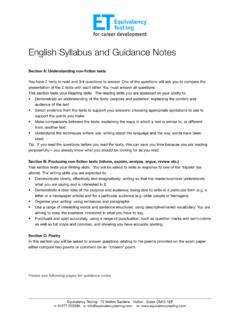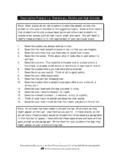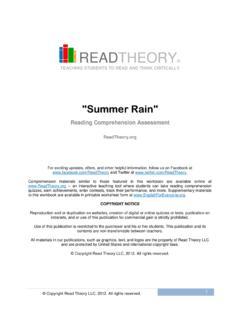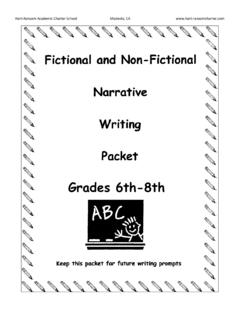Transcription of TheMaster TeacherSeries - teachingdoctors.com
1 TheMasterTeacherSeriesDescriptive WritingbyJohn Schacter, PURCHASE THE BOOK AND CD-ROM GO TO OR CALL Copyright John Schacter, TheMasterTeacherSeriesDescriptive WritingPreface LESSON 1: Pretest and Portfolios LESSON 2: Introduction to descriptive writing LESSON 3: The Snow Person (Attribute Charts) LESSON 4: The Storm (Where Topic Sentences)LESSON 5: The Storm (Top to Bottom Paragraph Frames) LESSON 6: The Storm ( writing Concluding Sentences) LESSON 7: The Storm (Revising for Precise Language) LESSON 8: The Playground (When Topic Sentences)LESSON 9: The Playground (Left to Right Paragraph Frames)LESSON 10: The Playground ( writing Concluding Sentences)LESSON 11: The Playground (Revising for Strong Verbs)LESSON 12: The Insect (Skill Review & Attribute Charts)LESSON 13: The Insect ( writing Comparison Sentences)LESSON 14: The Insect (Details Paragraph Frame)LESSON 15: The Insect (Interesting Fact Topic Sentences)LESSON 16: The Insect ( writing Concluding Sentences) 8 11 15 18 22 26 31 35 40 45 49 55 60 63 67 70 75 ContentsContents ContinuedLESSON 17: The Insect (Skill Review) LESSON 18: The Place (Creating Attribute Charts) LESSON 19: The Place (Precise Words, Verbs & Comparisons Draft) LESSON 20: The Place (Evaluate & Rewrite) LESSON 21: descriptive writing PosttestLESSON 22: Pretest to Posttest Growth (Self-Evaluate)LESSON 23: Sentence Combining LESSON 24: writing Multi-Paragraph Essays LESSON 25: The Stuffed Toy (Creating Attribute Charts)LESSON 26: The Stuffed Toy (Essay Organizer)LESSON 27: The Stuffed Toy ( writing Your First Draft)LESSON 28: Sentence Combining LESSON 29: The Stuffed Toy ( writing Orientations)LESSON 30: The Stuffed Toy ( writing Closing Paragraphs)LESSON 31: The Stuffed Toy (Self-Evaluation & Feedback) LESSON 32.
2 The Stuffed Toy (Evaluating Classmates Essays)REFERENCES 79 85 88 93 97 99 103 106 108 113 117 121 128 132 135 141 146 TO PURCHASE THE BOOK AND CD-ROM GO TO OR CALL PrefacePrefaceModel Texts, Pictures and Skill Development Activities Teaching writing involves careful selection of pictures, model texts, prompts, rubrics, and skill development activities. Consider-able time and effort were spent creating the Teacher PowerPoint Slides and Student Workbooks that house these materials. While the descriptive writing skills taught in this book remain the same each year, the model texts, activities, and perfor-mance demands change based on grade- level expectations. Lesson ProgressionLessons progress from writing simple descriptive sentences to paragraphs to multi-paragraph essays. Skill development exercises range from generating descrip-tive attributes to sentence combining to including comparisons and hyperbole. Some first-and second-grade students may not be ready to compose multi-paragraph descriptions.
3 Others may. We encourage teachers to use their judgment to decide how far through this curriculum each stu-dent is prepared to advance. As educators, we know that students learn at different rates and enter every grade with different performance levels. That being said, a pos-sible ending point for lower elementary students (grades 1 to 3) is Lesson 21. This book and accompanying CD ROM incorporate the best in educational research with classroom practices that show the theory in action. In this volume, we present 32 lessons on how to teach descriptive writ-ing in grades 1 to 5. Each lesson is guided by experimentally proven writing strategies that increase student achievement from 13 to 86 percent (see reviews by Hillocks,1984, and Graham & Perin, 2007). In the pages that follow, lessons are described through visual storyboards. All lessons include Teacher PowerPoint Slides (with grade-level-specific model texts, prompts, pictures, and activities), and Student Workbooks stored on the accompanying CD ROM.
4 writing this book and developing the teach-ing examples would not have been possible without the creativity of classroom teachers, researchers, and state department educa-tors. Thank you, Dr. Gina Koency, Katie Welch, Janet Grevious, Dr. Phyllis Veith, Ellen Oderman, Paula Wykle, and Kathy Mears for your instructive comments and encourage-ment! Appreciation is also expressed to Jennifer Duke for her graphic design, Paul Kepple for his innovative cover artwork, and Joanne Michiuye for her meticulous copyediting. Lastly, thank you Nikki Serafin for your abundant creativity and wealth of PURCHASE THE BOOK AND CD-ROM GO TO OR CALL 5 Defining descriptive writing and How to Use This BookIn a recent review of experimental writ-ing studies, Graham & Perin (2007) dem-onstrated that students taught the Goals and Progress Feedback approach gained on average 26 percent more on a variety of writing assessments than similar students randomly assigned to control groups.
5 The Goals and Progress Feedback writing ap-proach includes: 1. INTRODUCING THE writing GOAL2. MODELING THE writing SKILL3. PRACTICING THE SKILL OUT OF CONTEXT 4. USING THE SKILL IN CONTEXT5. RECEIVING IMMEDIATE FEEDBACK 6. RETEACHING AND/OR EXTENDING SKILL USEI mproving writing Requires Expert Instruction and PracticeDon t expect your students to master all the descriptive writing skills introduced in this eight-week curriculum. These skills need to be retaught and reinforced throughout students elementary education. How to Use This Book This book is a curriculum with 32 descrip-tive writing lessons. Accompanying this book are grade-level-specific Teacher PowerPoint Slides and Student Workbooks. While the writing skills and strategies are the same each year, the prompts, pictures, model texts, examples, and writing exer-cises change for each grade level. The descriptive writing Skill Sheet on the next page shows the writing skills you will teach.
6 Each X represents how many times that skill is introduced. What Is descriptive writing ? descriptive writing describes a person, place, or thing in a way that enables the reader to visualize it. This type of writing is characterized by: sensory details, precise language (tulip instead of flower; mansion instead of home), comparisons (under the jeweled sky; speaks like a queen), strong verbs (He slammed the book down.), and hyperbole (faster than a speeding bullet; strong as an ox).Why Write Descriptively? writing descriptively teaches students to: organize their thinking, search for and communicate details, define people, places and things, and write with clarity and purpose. Teaching descriptive writing Rather than teach writing using a singu-lar approach ( process writing , rubrics, study of models, collaborative writing , self-regulation strategies, scaffolds, etc.) we employ a variety of experimentally proven strategies (see Reference section).
7 While your students will experience ele-ments of process writing , study of models, rubrics, collaborative writing , and self-reg-ulation strategies, the guiding instructional approach in this book is called Goals and Progress Feedback (Schunk & Swartz, 1993). 6 descriptive writing Skill SheetGenerates attribute charts to develop and sort ideas and details for descriptive concluding sentences that use a concluding word or phrase, give advice, or summarize the descriptions either by time, visual field (left to right; top to bottom; small to large), details, or topic sentences that orient and engage the SKILLSUses precise language (tulip instead of flower; mansion instead of home).Uses transitions (Before, During, After .. In front of, Behind, Beside) and sentence variation (combines choppy sentences, revises repetitive sentence starts).Uses words that engage and surprise the reader (enormous shrimp; muscles bigger than a mountain).*Includes strong verbs (She raced to the park.)
8 He gulped down his lunch.).Includes descriptive words and details (look, sound, movement, taste, composition, age, size, location, etc.).Makes comparisons (fast as lightning, hair like silk, hotter than burning coal).COMPOSING SKILLSD escriptive writing Skill SheetX X X X X XX X X X X X X X X X X X X X X X X X X X X X X X X X X X X X X X X X XX X X X X X XX X *This skill is taught in the 4th and 5th grade Teacher PP Lesson 4 72 Lesson 4: descriptive Paragraph #1, The StormOUTCOMESS tudents will: Write Where Topic Sentences. Create a descriptive attribute chart to describe a picture of a Teacher PP Slides Student whiteboards Red and Black dry erase markers Post It Notes Where Topic Sentence PosterPREPARATION Read the lesson , we have two writing goals. One is writing Topic Sentences, the other is generating descriptive attributes.
9 Open your workbooks and put a check next to: Writes topic sentences that orient and engage the reader. Put another check next to: Generates attribute charts. Writes concluding sentences that use a concluding word or phrase, give advice, or summarize the topic sentences that orient and engage the attribute charts to develop and sort ideas and details for descriptive SKILLSDESCRIPTIVE writing SKILL SHEETO rganizes descriptions either by time, visual field (left to right; top to bottom; small to large; large to small), or way to engage and orient a reader is to tell the reader WHERE what you re describing takes place. There are lots of ways to write WHERE Topic Sentences. On our writing bulletin board, I have placed several examples. In a min-ute, you ll practice writing different WHERE Topic Sentenc-es. writing WHERE TOPIC SENTENCES In the school gym .. Across the train tracks .. Inside our classroom .. At my friend s pool .. Next to the creek.
10 On the soccer field .. Outside my bedroom window .. 8 Lesson 46543I m going to write a WHERE Topic Sentence for this picture (volcano). When you write a WHERE Topic Sentence, first look at the Topic Sentence Poster for an idea. I m going to start with On the soccer field .. But this isn t a picture of a soccer field it s On the big island of Hawaii .. I ll write this with my BLACK marker on my dry erase s another picture (CITY). On your whiteboards, make an organizer that looks like this. First write the WHERE part of your Topic Sentence in BLACK, then write the WHAT HAPPENED part in RED. Share your topic sentence with your neighbor, then hold up your whiteboards. After I write WHERE, I need to write what happened. I ll say the volcano erupted, and write that in RED. Watch me write another WHERET opic Sentence. This time I ll start with Next to .. Next to my grandpa s sugar cane field.. Now, I need to write what happened in RED, I heard the volcano rumble.








